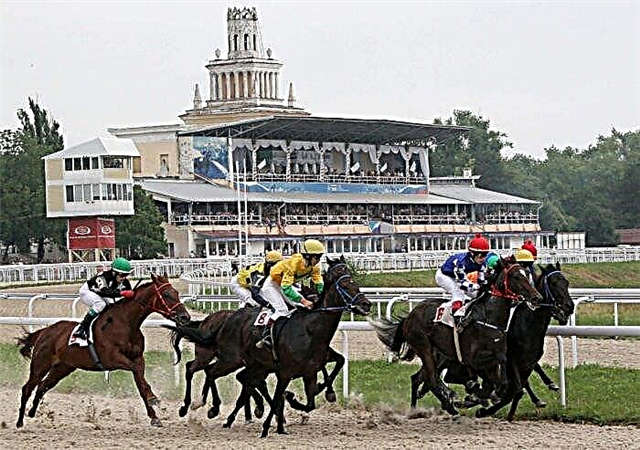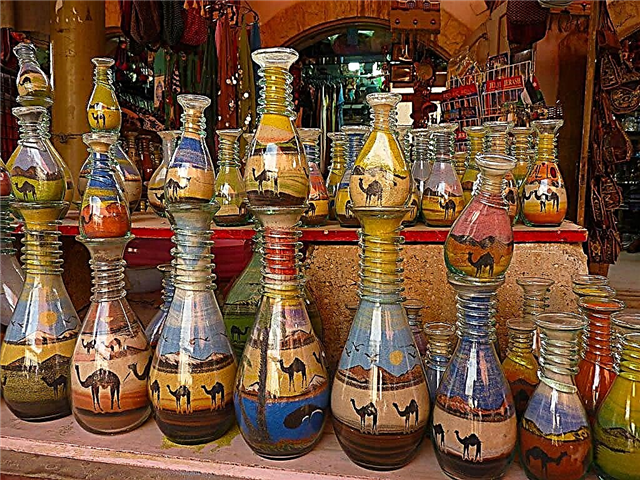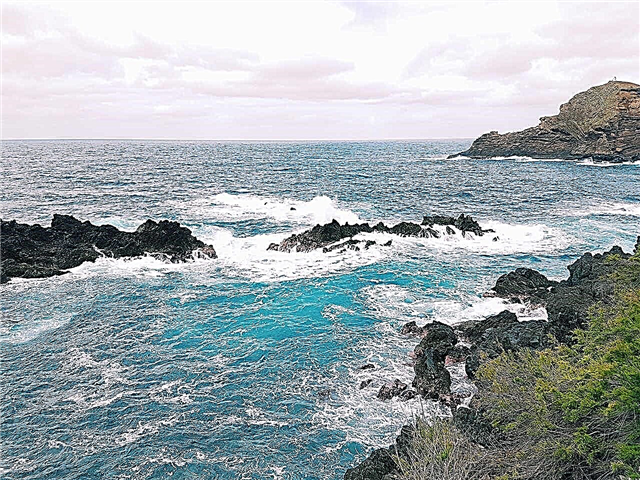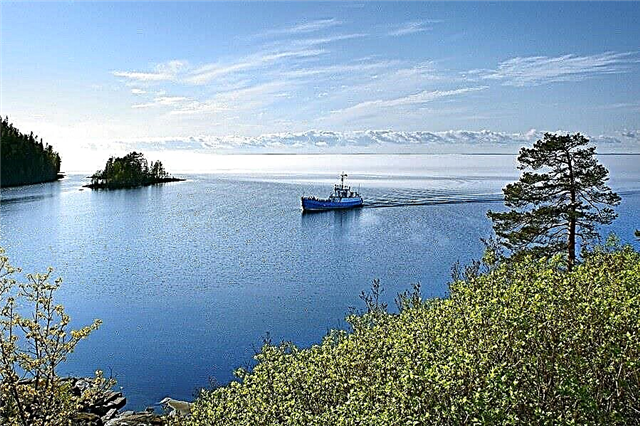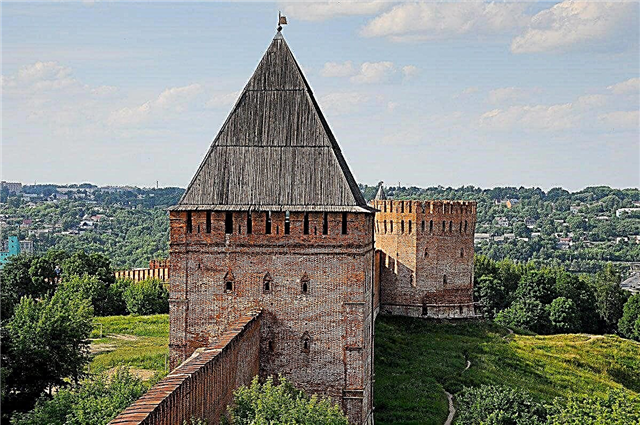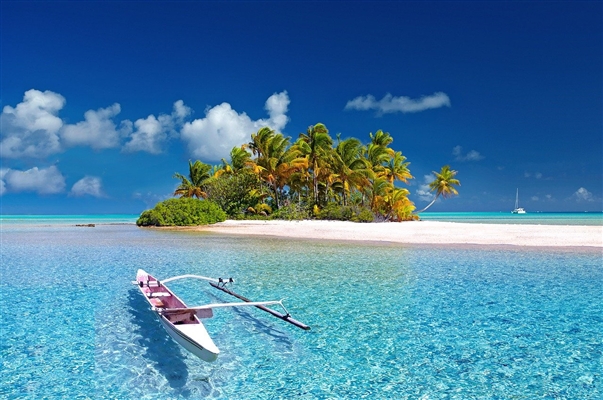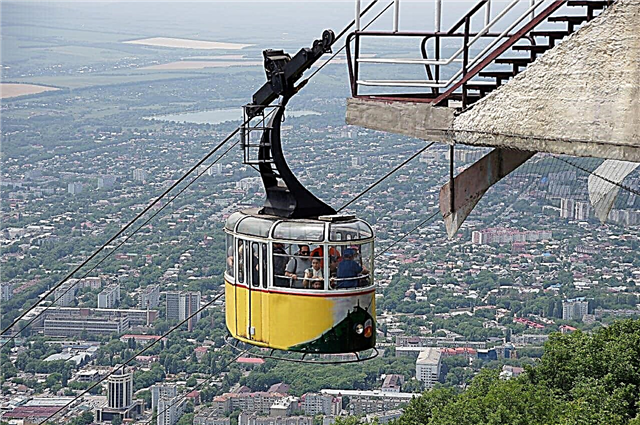Pyatigorsk is a resort town where vacationers will always have something to do. An important component of rest in it is visiting medical complexes with mineral water, most of which are equipped in beautiful and ancient buildings - Pushkin, Ermolovsky, Pirogovsky baths. Nature lovers will be interested in "shameless" baths, in which you can enjoy the beauty of the surrounding nature. You can also visit the lake with therapeutic mud Tambukan.
The life and work of the poet Lermontov are closely connected with Pyatigorsk. A visit to the "Lermontov" places is an obligatory part of the tourist excursion program. It is worth visiting the Lermontov's grotto and the poet's house, where a museum-reserve is set up, to lay flowers at the site of the fatal duel and at its monument. Many iconic places are located on the Mashuk mountain - Proval lake, "Eolova harp" gazebo, cable car.
The most interesting and beautiful places
List, photos with names and descriptions of the best sights of Pyatigorsk. He will help you plan routes for self-examination of the top places of the city in 2-3 days.
Lake Proval
A natural landmark of Mashuk Mountain and one of the most popular places in the city. The depth of the lake is 11 meters, the width is 15 meters. The reservoir was formed after the collapse of limestone rocks by 41 meters. The water in it is amazingly turquoise. An illuminated tunnel 40 meters long leads to the cave, in front of which there is an observation deck with views of Pyatigorsk. There are sculptures of lions at the entrance.

Read about all the top places in the region: the main attractions of the Stavropol Territory.
Place of Lermontov's duel
A glade on the slope of Mashuk, where a duel took place in 1841, in which M. Yu. Lermontov died. In this place in 1913, on the occasion of the 100th anniversary of the poet's birth, an obelisk of classical form was erected. In a round niche in the center of the obelisk there is a bust of the poet in an officer's uniform, made of bronze. The memorial is surrounded by a fence made of metal chains. Concrete bars are installed at the corners of the fence.

Mount Mashuk
The mountain, over 900 meters high, is one of the iconic landmarks of the city. It offers a magnificent view of the city, Mount Beshtau. On a clear day, you can see Elbrus from Mashuk. There are many mineral springs on the slopes of the mountain. Clean air and medicinal water attract vacationers to the sanatoriums of Pyatigorsk, built next to the mountain. You can climb the top of the mountain by cable car, on foot or by car.

Park "Flower garden"
One of the oldest cultural sites in the city. The beautiful park is the center of the resort life of Pyatigorsk. There are many interesting places in it - Lermontov Gallery, Ermolovsky Baths, Diana's Grotto, Drinking Gallery. Alleys, ornamental shrubs are planted in the park, about 40 types of flowers grow on flower beds. There is a fountain in the center of the park. From the park you can climb to the top of the mountain, where the eagle, the symbol of the city, is installed.

Pyatigorsk cable car
Opened in 1971, renovated in 2015. Leads to the top of Mount Mashuk. Travel time one way is 3 minutes. When climbing, beautiful views open up - of Pyatigorsk itself, the slopes of Mashuk and Beshtau. From a bird's eye view, you can see well the Lazarevskaya Church and the rock portrait of Lenin, created in 1925. Many tourists consider the cable car to be the most romantic place in Pyatigorsk.

Boulevard Gagarin
It appeared during the construction of a tunnel to Lake Proval in the middle of the 19th century. The official name appeared in 1968, before that the boulevard was simply called "failure". Now it is a cozy pedestrian zone where you can walk under the shade of trees and admire the architecture of houses of the early 20th century. There are benches on the green alleys, a fountain is installed. The boulevard is laid between the sanatoriums and is a favorite walking place for vacationers.

M. Lermontov Museum-Reserve
Also known as "Lermontov's house". The poet lived in it the last days of his life. Since then, the house has been preserved in almost the same form. The museum displays many personal belongings of Lermontov. The expositions have different themes. They talk about Lermontov's life in the Caucasus, about his images in music and painting. The guides conduct an excursion not only to the museum-reserve, but also to all the "Lermontovsky" places in Pyatigorsk.

Signs on the top of Mashuk mountain
Poles on the observation deck near the cable car, on which there are signs with the names of cities and the distance to them from Mashuk. In total, there are about 10 such pillars on the top of the mountain, each of which has up to 20 signs. Cities from almost all over the world are located - Kharkov, Los Angeles, Tver, Murmansk, London. Anyone can buy a sign, write their city on it and attach it to a post.

Lermontov gallery
A simple but graceful building is one of the main architectural symbols of Pyatigorsk. The gallery stands out for its unusual blue glass and metal construction. By its appearance, it resembles an elegant and fabulous palace. The 800-meter pavilion houses a dance floor and an auditorium with a capacity of 600 people. The gallery hosts concerts and performances, and the exhibition hall hosts art events.

Academic gallery
An architectural structure in the park Flower garden, which Lermontov often visited. Built in 1951 from Mashuk stone. The project of the gallery in the form of an Italian palazzo was carried out by the architect Upton, who received the title of academician for him. A gallery was built around the first mineral spring discovered in the city. They took medicinal baths in it. Now you can drink mineral water here and enjoy the beautiful views.

Diana's grotto
Appeared in memory of the first ascent of Elbrus by a scientific expedition. Originally it was called Grotto Elbrus. The Bernardazzi brothers worked on the creation of the grotto. Memorial plaques are installed at the entrance to the artificial cave. The main entrance to the cave is decorated with massive columns. The area in front of the entrance is paved with stone slabs. In this charming place, M. Lermontov organized the last ball in his life.

Lermontov's grotto
Small natural cave in Mashuk mountain. The picturesque place was popular with the Pyatigorsk "water" society. Lermontov also often visited the grotto, so after the poet's death, the inhabitants of the city began to call the grotto in his honor, later the name "Lermontov's grotto" was made official. There is a memorial plaque at the entrance; the grotto itself is considered a federal architectural monument and a historical heritage site.

Stavropol Operetta Theater
The history of the theater begins in 1939. Both adult performances and fairy tales for children are staged in the theater. Spectators appreciate the performances for their brilliant acting, colorful scenery and costumes, and excellent choreography. An interesting format was the holding of performances in the Open Air style at the site at the main entrance to the theater. The theater building looks elegant and stylish. Stucco moldings and columns are used in the interior design.

Architectural landmarks of Pyatigorsk
The most famous and notable monuments of architecture and urban planning.
Gazebo "Aeolian Harp"
An unusual rotunda is located at the Mikhailovsky spur on Mount Mashuk. From this place, picturesque views of the outskirts of Pyatigorsk, the city itself and the Caucasian ridge open up. The gazebo was named in honor of the god of the winds Aeol. In 2008, an acoustic system was installed in it, reproducing the melody of the harps. In the evening, the gazebo is beautifully illuminated. The gazebo is included in the list of Pyatigorsk "Lermontov" places.

"Chinese gazebo"
Located next to the eagle sculpture - the symbol of the city. A walking path along Goryachaya Mountain leads to it.The gazebo got its name because of the bizarre silhouette of the roof, similar to the roof of Buddhist temples. "Chinese gazebo" was built in 1976 on the site of the destroyed "flower gazebo". It is an openwork metal pavilion. It is good to sit in it, enjoying beautiful views of the local landscapes.

Ermolovsky baths
Mud treatment complex in the Park Flower Garden. Built in 1821 on the initiative of General Ermolov. The therapeutic baths were visited by Pushkin, Raevsky, Glinka. The building project was developed by the architect Grozman. Its walls of yellow and red bricks are lined with curly masonry. The building has the shape of two connected crosses, in the center of each cross a dome rises. Now the mud bath is used to treat gynecological diseases.

Pushkin baths
One of the largest balneological facilities of the early 20th century. It was built at the foot of Goryachaya Mountain, in the place where Lermontov was a child in a small wooden house. It was these landscapes that aroused the poet's admiration, which he expressed later in his work. Bath buildings look solemn and elegant, they are decorated with stucco, ornaments and small turrets. Various architectural styles are used in the design.

Pyatigorsk necropolis
The oldest cemetery in the North Caucasus, where prominent honorary residents of the city are buried - doctors, artists, soldiers, scientists. Their graves are decorated with beautiful tombstones and monuments. For tourists this is an opportunity to get acquainted with the history of the city. At the entrance to the necropolis in 1902, the church of Bishop Lazarus was built in the classical style. The necropolis is located on a hill with a good view of the city.

Mikhailovskaya gallery
Built in 1848 near the sulfur-salt Mikhailovsky spring. The graceful building is made in the Moorish style. The source is enclosed in a round basin, which is a bowl of black marble. After removing the mineral water source outside, the Spa Museum was placed within the walls of the gallery. The building was reconstructed and the interior was renewed. The exhibition halls display works by contemporary artists.

Pirogov baths
Medical complex and architectural landmark of Pyatigorsk. Built in 1913. The facade is made in the Roman style and is decorated with a mosaic panel depicting the spirits of mineral water and bathing scenes. The architect of the project was S.V. Tilicheev, since 1914 the building was called the Tilicheev baths. The baths were given back their historical name "Pirogovskie" in the 1960s. A bust of the famous surgeon was installed at the entrance.

Dacha of brothers Titz
The three-storey building is located in the historical part of the city. By its appearance, the building in the Art Nouveau style is more reminiscent of a palace than a country house. The original building was built at the beginning of the 20th century. Its facade is interestingly executed from all sides. The third floor of summer cottages is decorated with turrets, domes, balconies, and a mezzanine. Currently, the building of a military sanatorium is located in the former building of summer cottages.

Fountain "Fairy Tale"
The grandiose fountain was built in 1902. It was a complex hydraulic engineering structure. In 1910, the decoration of the fountain was changed. Now it is an original structure in the form of stone grottoes, in the decorations of which the stone features of bearded gnomes appear. For more than 100 years, the fountain has not lost its appearance due to renovations. In 2010, the fountain was supplemented with multi-colored lighting.

Natural sights of Pyatigorsk
The best places for outdoor recreation, gardens and parks, beautiful lakes.
Mount Beshtau
Five-headed igneous mountain 1400 meters high. Its peaks and spurs have original names - Goat Rocks, Fox Nose, Shaggy Kurgan. The mountain is surrounded by a ring dirt road. You can get to the peaks on foot, without any special physical training. The laid out hiking trails have healing springs - hot and cold. At the foot of the mountain there is a restored 9th century Assumption Monastery.

"Shameless Baths"
Also called "folk baths". They are natural bowls with hydrogen sulfide water. Cascades of several baths are located in the wilderness, with no comfy amenities. Tourists appreciate such places because of the opportunity to use natural healing gifts free of charge and without waiting in line. In the hottest upper baths, the water temperature is 70-80 degrees.

Park of Culture and Leisure named after Kirov
Formerly the State Garden was called, and fruit trees, poplars, acacia, lilacs, and several types of roses grew in it. Many of these trees still grow in the park. The area of the park is 22 hectares. Its territory is landscaped - alleys are laid, there are cafes, attractions, climbing wall, mini-zoo, mirror maze, playgrounds. You can go boating on the lake in the park. On the island in the lake live pheasants, rabbits, swans, which can be fed.

Lake Tambukan
Salt lake surrounded by forest, 9 km from Pyatigorsk. Its sulphide silt mud is used in many mud baths and sanatoriums. In total, there are about one and a half million tons of useful medicinal mud at the bottom of the lake. It is believed that its properties practically do not differ from the Dead Sea mud. The wagon of the lake is saturated with various minerals, it is worth swimming in it with caution and taking into account medical contraindications.

Novopyatigorskoe Lake and Victory Park
The lake was formed in the Victory Park in the middle of the 20th century with the help of a dam on the Podkumok River. In 2015, the shores of the lake were landscaped, the water was changed, and the bottom was cleaned. It is officially allowed to swim in it. A separate area for fishing lovers has been allocated. A cascade fountain is located on the slopes of the dam. On the site in front of him in the park, solemn events are held. An 8-meter Pobeda stele is installed in the center of the park.

Perkala dendrological park
Located on the slope of Mashuk Mountain. The area of the park is 40 hectares. It was founded at the beginning of the 19th century by the demoted officer Perkalsky, who planted seedlings of plants from different parts of Pyatigorye near his house. Currently, it is home to hundreds of species of trees, shrubs and herbaceous plants. There are plants that do not grow in Europe. Among the unique trees - ginkgo biloba, which exists in the Mesozoic era.

The best museums in Pyatigorsk
The most interesting museums in the city, which are definitely worth a visit.
Pyatigorsk Museum of Local Lore
Opened in 1903. The collection was replenished through archaeological excavations. This is how fragments of the skeleton of a southern elephant, which lived more than a million years ago, appeared in the museum. The total number of exhibits in the museum is more than 130,000. Unique zoological, historical, mineralogical, numismatic collections have been collected. There are paintings by Shishkin, Bogolyubov, Savrasov. Separate expositions are devoted to the history of the region.

Museum of Stone Antiquities
One of the most unique museums in the North Caucasus. Its exhibits are stone statues, statues and sculptures, dolmens, millstones, sacrificial stones made in ancient times. Monuments of stone creation have been found in the territory of the North Caucasian region. The museum is located in the open air on the slope of Goryachaya Mountain. Information stands were installed with a story about the exhibits and the life of the Caucasian peoples.

Insect museum
The museum was founded in 1995 by the entomologist Tikhomirov. The museum's collection contains thousands of insects from all over the world, including tropical ones - butterflies, cockroaches, spiders, beetles, scorpions. There are other animals - lizards, snakes, frogs. The unique inhabitants of the museum are the royal snake, the tarantula, the imperial scorpion. In a special room, you can observe the full life cycle of butterflies. Guided tours are provided by the museum staff.

Monuments and monuments of Pyatigorsk
Famous historical and modern monuments and memorials of the city.
Memorial complex "Fire of Eternal Glory"
The grandiose memorial complex is located on Lenin Square.It consists of five pairs of basalt columns, a marble bowl with the Eternal Flame, mass graves with tombstones and bas-reliefs. The main bas-relief is "Motherland", the rest of the bas-reliefs are dedicated to the memory of those killed during the occupation and the feat of the defenders of the region. The entire complex is a symbol of the courage of the soldiers and the inaccessibility of the Caucasus Mountains.

Sculpture "Eagle"
It is located on Goryachaya Mountain, where the first source of mineral water was found. The sculpture was installed at the beginning of the 20th century for the 100th anniversary of Pyatigorsk. Replaced in 1973. The eagle is a symbol of the Caucasian Mineral Waters. The sculpture of an eagle depicts the healing properties of the mineral water for which the region is famous, and the snake, which is tormented by the eagle, is a symbol of diseases that can be cured by natural spring water.

Monument to Lermontov
The monument was erected in 1889. It took 18 years to collect money for the installation of the monument. The monument was made by the sculptor Alexander Opekunshin. Many experts believe that the monument to Lermontov in Pyatigorsk is the best of all the poet's monuments in the country. He is depicted in an officer's coat and overcoat, in his eyes, looking into the distance, you can see inspiration. The bronze statue was cast in St. Petersburg, the pedestal is made of Crimean granite.

Monument to Kisa Vorobyaninov
A sculpture of a character from the novel and film "12 Chairs" is installed in the Flower Garden park. It is located in the very place where the character asked for alms in the story. Next to Vorobyaninov is a begging hat, into which tourists throw money. The nose of the sculpture is rubbed to a shine - there is a belief that the one who rubs the hero's nose will be financially successful. Local businessmen sponsored the installation of the monument.

Monument to Ostap Bender
Located at the entrance to the tunnel leading to Lake Proval. At this very place, the great strategist was selling non-existent tickets for visiting a natural attraction. Bender is leaning on one of the chairs, which the characters of the novel "12 Chairs" hunted for. The sculptural Bender does not look like its prototype from the motion picture. However, his appearance fully corresponds to the description of the character in the novel by Ilf and Petrov.

Monument to General A.P. Ermolov
The sculpture of the hero of the Patriotic War was installed in Nadezhda Park in 2010. Before the installation, the square in the park was restored. The unveiling of the monument was attended by a delegation of the Kuban Cossack society. Cossacks from all over the country collected money for the installation of the monument. The equestrian sculpture of the general is made in full growth. It is made of bronze and installed on a two-meter granite pedestal.

Gate of Love
One of the most favorite places among tourists on Mount Mashuk. The Gate of Love, sometimes called the Gate of the Sun, is located on a panoramic observation deck. The arch of the gate is made of large stones. Newlyweds and couples in love often come to her for a photo session. It is believed that if you make a wish under the arch, it will certainly come true. And if the groom carries the bride under the arch three times, they will have a happy family life.
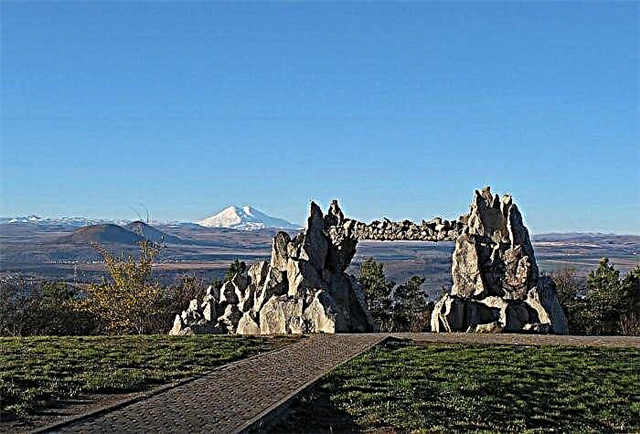
Churches and monasteries of Pyatigorsk
The main places of worship and Orthodox sights.
Spassky Cathedral
The main temple of the city, the construction of which began in 1845 and ended in 1867. The cathedral stood until 1936, when the Bolsheviks blew it up. The restoration of the temple began in the 1990s, it was consecrated in 2013. The cathedral was given its original appearance in the Russian-Byzantine style. It has a strict cross shape, and the facade of the snow-white walls is devoid of bright decorations. The interior of the cathedral is decorated with frescoes and an iconostasis in the Fryazh style.

Assumption Second-Athos Monastery
Located near the Beshtau mountain. The monastery was founded by monks from Mount Athos in 1904 on the site of a Byzantine temple from the times of ancient Alanya. After the closure of the monastery in 1927, the buildings of the monastery gradually turned into ruins. The restoration of the monastery began in the 1990s. The modern appearance of the monastery is very different from the original. The fraternal body is interestingly made - it has a cylindrical shape.

Church of Lazarus the Four-Day
A working temple located next to the necropolis. Built in 1902 on the site of a dismantled church from 1856. The temple was built in the style of Old Russian classicism in the shape of a cross. The brick walls are decorated with figured masonry. They have narrow windows. Many people note the beautiful interior decoration. The shrine of the church is the relics of St. Lazarus the Four-Day. Divine services in the Lazarevskaya church were held even under Soviet rule.
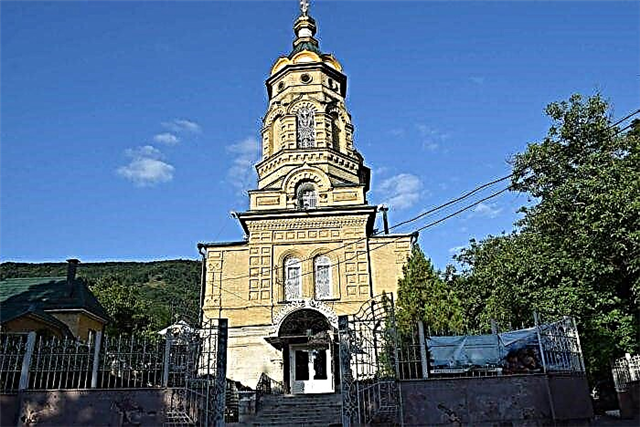
What else to see and where to go?
A few more interesting places that you can visit if you have already seen all the main attractions.
Glade of Songs
A concert venue built for mass celebrations. Located in a picturesque place on Mount Mashuk near the Gate of the Sun and the place of Lermontov's duel. The relief of the area made it possible to erect it in such a way that what was happening on the stage could be seen from any point. The natural slope of the mountain serves as an auditorium. After a long desolation, the Polyana of Songs was reconstructed in 2007.

Upper Market
Located in the center of the city. Shopping malls appeared at this place back in 1956. Due to the fact that mainly agricultural products were sold here, it was called Kolkhozny. The market is currently being rebuilt. The historic buildings house modern shops. A large food court with an area of 1500 m² is called Cuisines of the World, where you can taste national dishes from different countries.

Aquapark "City of the Sun"
Located in the village of Inozemtsevo, 15 km from Pyatigorsk. It has 12 water attractions and 9 swimming pools. For younger visitors, there are 2 separate 12-meter slides and 3 swimming pools. The fall effect can be felt on the "Cannon" slide. Popular slides are the spiral "Toboggan", "Hydroturbo" with a length of 113 meters and the swirling "Anaconda". Lying on sun loungers, you can admire the picturesque landscapes around.

Pyatigorsk Hippodrome
Built at the foot of Mount Beshtau. The first races took place in 1885. Currently, it is one of the largest racetracks in the country. About 500 horses of different breeds are tested on it every year. In 2008, a large-scale reconstruction took place. The race track has been modernized, irrigation and drainage systems have been installed, allowing races to be carried out in any weather. A good view opens from the spectator stands.
